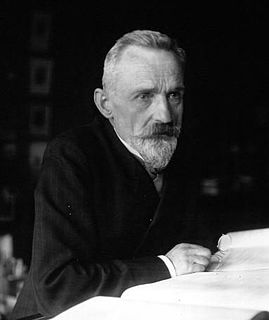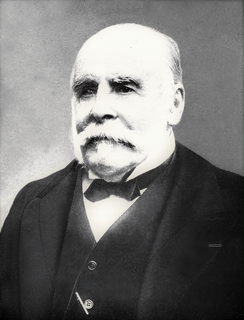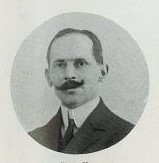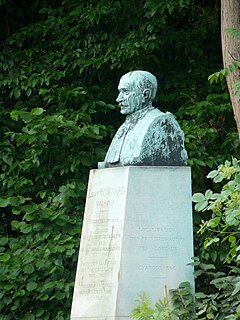François Louis Henri Coutière (4 March 1869 in Saulzet – 23 August 1952 in Orvilliers) was a French zoologist, who specialized in the field of carcinology (crustaceans).
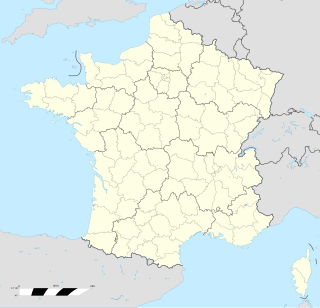
Saulzet is a commune in the Allier department in Auvergne-Rhône-Alpes in central France.

Orvilliers is a commune in the Yvelines department in the Île-de-France region in north-central France.
Carcinology is a branch of zoology that consists of the study of crustaceans, a group of arthropods that includes lobsters, crayfish, shrimp, krill, barnacles and crabs. Other names for carcinology are malacostracology, crustaceology, and crustalogy, and a person who studies crustaceans is a carcinologist or occasionally a malacostracologist, a crustaceologist, or a crustalogist.
In 1895 he received his bachelor's degree in natural sciences, and during the following year, obtained his pharmacy degree 1st class. By way of a recommendation from Alphonse Milne-Edwards, he embarked on a zoological mission to the Red Sea in 1897 on behalf of the Muséum d'Histoire Naturelle. In 1899 he was named chef de service under Milne-Edwards in the laboratory of anatomic zoology at the École des hautes études. [1]

Alphonse Milne-Edwards was a French mammalologist, ornithologist and carcinologist. He was English in origin, the son of Henri Milne-Edwards and grandson of Bryan Edwards, a Jamaican planter who settled at Bruges.

The Red Sea is a seawater inlet of the Indian Ocean, lying between Africa and Asia. The connection to the ocean is in the south through the Bab el Mandeb strait and the Gulf of Aden. To the north lie the Sinai Peninsula, the Gulf of Aqaba, and the Gulf of Suez. The Red Sea is a Global 200 ecoregion. The sea is underlain by the Red Sea Rift which is part of the Great Rift Valley.
The École pratique des hautes études, abbreviated EPHE, is a Grand Établissement in Paris, France, and a constituent college of PSL Research University. It is counted among France's most prestigious research and higher education institutions. It is highly selective and member of the elite Université PSL. Its degrees in religious studies and in history count among the best in the world. Closely linked to École française d'Extrême-Orient and Institut français du Proche-Orient, EPHE has formed continuously world-class experts in Asian and Islamic studies and among them investment bankers, diplomat and military officers specialized in these areas. Particularly, leading researchers in military strategy have taught in EPHE for more than a century. Moreover, famous researchers in natural sciences teach and taught in EPHE. Highly regarded for its top level in both natural and human sciences, EPHE has relations and exchange programs with world-renowned institutions such as Cambridge, Princeton, and Al-Azhar.
In 1899 he obtained his doctorate in natural sciences with a dissertation-thesis on the snapping shrimp family Alpheidae, and during the following year began teaching classes in zoology at the École supérieure de Pharmacie in Paris. From 1902 to 1937 he was a full professor of zoology at the school of pharmacy. [1] [2]
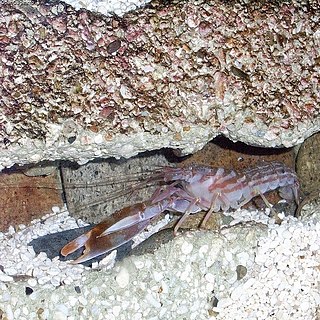
Alpheidae is a family of caridean snapping shrimp characterized by having asymmetrical claws, the larger of which is typically capable of producing a loud snapping sound. Other common names for animals in the group are pistol shrimp or alpheid shrimp.

Paris is the capital and most populous city of France, with an area of 105 square kilometres and an official estimated population of 2,140,526 residents as of 1 January 2019. Since the 17th century, Paris is one of Europe's major centres of finance, diplomacy, commerce, fashion, science, and the arts.
In 1910 he was appointed president of the Société zoologique de France. The shrimp genera Coutierea and Coutierella (family Palaemonidae) commemorate his name, as do species with the epithet coutierei; e.g. Stenothoe coutieri ( Chevreux, 1908). [3]
La Société zoologique de France, founded in 1876 by Aimé Bouvier, is a scientific society devoted to Zoology. It publishes a bulletin and organises the Prix Gadeau de Kerville de la Société zoologique de France.

Palaemonidae is a family of shrimp in the order Decapoda. Two subfamilies are distinguished: Palaemoninae and Pontoniinae. Palaemoninae are mainly carnivores that eat small invertebrates and can be found in any aquatic habitat except the deep sea. The most significant genus is Macrobrachium, which contains commercially fished species. Pontoniinae inhabit coral reefs, where they associate with certain invertebrates such as sponges, cnidarians, mollusks and echinoderms as cleaner shrimps, parasites, or commensals. They generally feed on detritus, though some are carnivores and hunt tiny animals.
Édouard Chevreux was a French carcinologist.



